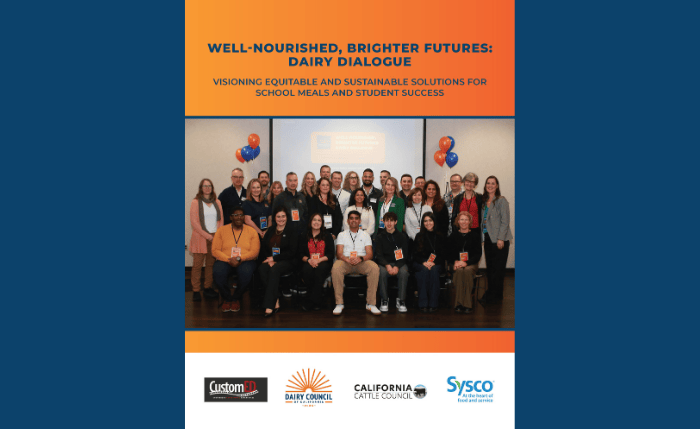
At Dairy Council of California, we believe that every child deserves access to nourishing meals that fuel not only their health, but their potential. Achieving this vision requires more than a single solution or one sector. It necessitates a collaborative effort across education, health, agriculture and communities.
Well-Nourished, Brighter Futures: Dairy Dialogue: Visioning Equitable and Sustainable Solutions for School Meals and Student Success was established from that belief—a desire to gather insights, build connections and identify practical ways to advance school meals. Our goal was to bring together diverse voices with one shared commitment: advancing student wellness by shaping equitable, sustainable and inclusive school meals that reflect the needs of California’s youth.
This report reflects the momentum, shared vision and spirit of partnership sparked by our recent efforts. It highlights both the challenges ahead and the exciting opportunity to work together in reimagining school meals—integrating nutrition education, expanding culturally relevant dairy offerings and reinforcing local food systems to better serve the health and well-being of all students.
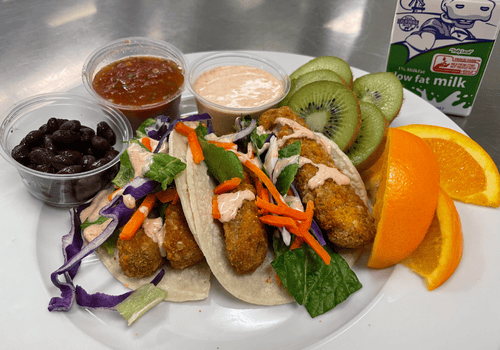 Creating meaningful change in school nutrition takes insight from every corner—schools, communities and agriculture.
This report brings those perspectives together and charts a path for shared progress.
Creating meaningful change in school nutrition takes insight from every corner—schools, communities and agriculture.
This report brings those perspectives together and charts a path for shared progress.
I’m incredibly proud of the leadership our team demonstrated in bringing this effort to life—convening partners, listening, co-creating a vision and fostering meaningful collaboration. Thank you to the California Cattle Council for their support, to CustomEd for skillfully facilitating the dialogue process and to Sysco Sacramento for their generous hospitality during the convening. Appreciation also goes out to our advisory committee for their insight and leadership throughout the process. Each of these partners played a vital role in advancing this important work unifying voices around the future of school meals.
I invite you to explore the findings, reflect on the learnings, and consider how you, too, can be part of this collective movement toward a well-nourished, brighter future for all students.
With gratitude,

Amy DeLisio, MPH, RDN
Chief Executive Officer
Dairy Council of California

Dairy Council of California convened Well-Nourished, Brighter Futures: Dairy Dialogue in January 2025 for school nutrition leaders—including dietitians, school nutrition professionals, farmers, youth and dairy processors—to foster dialogue and build meaningful connections.
This event was intended to explore strategies that:
The day’s conversations yielded five key areas of focus:

In fall 2024, Dairy Council of California launched a multi-pronged endeavor to support scholar success to ensure long-term access to nutrient-dense school meals. Child nutrition programs play an important role in supporting children’s health and ability to learn. Research suggests that eating nutrient-dense foods like fruits, vegetables and dairy products that are made readily available in school meal programs is associated with improved academic and health outcomes among children and adolescents.i Dairy is an important component of school meals, providing key nutrients that support optimal growth and overall health but are currently under-consumed by most children.ii Consuming the recommended number of daily servings of dairy foods can help close the gap on some nutrient intakes, including calcium, vitamin D and potassium.iii
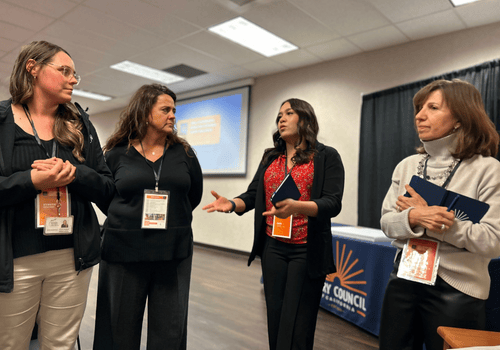 First, to gain different perspectives on the changing environment of school nutrition, an advisory council of school nutrition professionals and dairy community leaders was established to help advise and guide the endeavor. Next, Dairy Council of
California partnered with DataLink Partners to conduct interviews with several school nutrition directors and California school milk and dairy processors to better understand the landscape shaping school meals and scholar success. Lastly, based on insights
from these interviews, Well-Nourished, Brighter Futures: Dairy Dialogue convened in January 2025 in Sacramento.
First, to gain different perspectives on the changing environment of school nutrition, an advisory council of school nutrition professionals and dairy community leaders was established to help advise and guide the endeavor. Next, Dairy Council of
California partnered with DataLink Partners to conduct interviews with several school nutrition directors and California school milk and dairy processors to better understand the landscape shaping school meals and scholar success. Lastly, based on insights
from these interviews, Well-Nourished, Brighter Futures: Dairy Dialogue convened in January 2025 in Sacramento.
This event brought together representatives from school nutrition programs, the California dairy community and state nutrition and agriculture leaders around the shared vision of advancing student success by increasing access to nutrient-dense foods at
school. Participants also explored strategies to reduce waste, expand local dairy purchasing and collectively support school nutrition programs to meet evolving nutrition standards and sustainability goals. Using the What, So What, Now What process,
a reflective model for systems thinking, the dialogue explored a variety of aspects of school meals to identify challenges, opportunities and actionable solutions.
This report presents findings based on surveys conducted both pre- and post-event,
as well as information captured from Dairy Dialogue attendees via group discussions, interviews and written notes.
Dairy Council of California commissioned a series of Key Informant Interviews that provided crucial insights and shaped the Dairy Dialogue. This What phase of the dialogue had a simple goal: to hear diverse perspectives on serving nourishing, sustainable school meals while complying with federal and state regulations. Participants in these interviews identified three core shortfalls:
These core themes, combined with questions drawn from attendee registration surveys, allowed the Dairy Dialogue team to carefully craft the day’s agenda, ensuring the conversations would support attendee and partner needs, both on the day of the gathering and moving forward.
The conversations at the center of the Dairy Dialogue made up the So What phase, in which attendees listened to expert speakers who shared their valuable knowledge, followed by interactive activities and dialogue. Attendee contributions were crucial to the future of dairy in school meals:
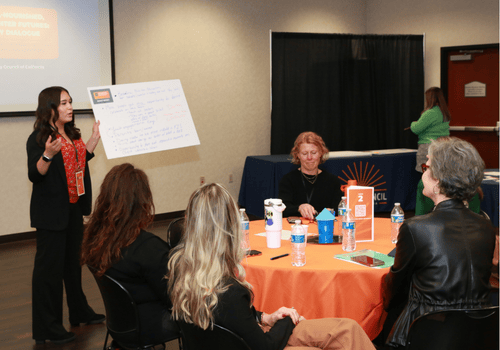 DAIRY INNOVATION DIALOGUE
DAIRY INNOVATION DIALOGUE
NUTRITION EDUCATION DIALOGUE
 FUTURE OF SCHOOL MEALS DIALOGUE
FUTURE OF SCHOOL MEALS DIALOGUE
PROFESSIONAL DEVELOPMENT AND TRAINING DIALOGUE
Attendee reflections after the Dairy Dialogue made clear the value in bringing together thought leaders from a wide variety of backgrounds. One hundred percent of respondents that took the post-event survey expressed their confidence that the information they learned and the connections they made would continue to benefit them. Attendees specifically highlighted learning new strategies to incorporate dairy foods into school meals. The survey results consistently emphasized the need for child nutrition advocates statewide to champion student success through increased access to nutrient-dense school meals, specifically highlighting the inclusion of milk and dairy products.
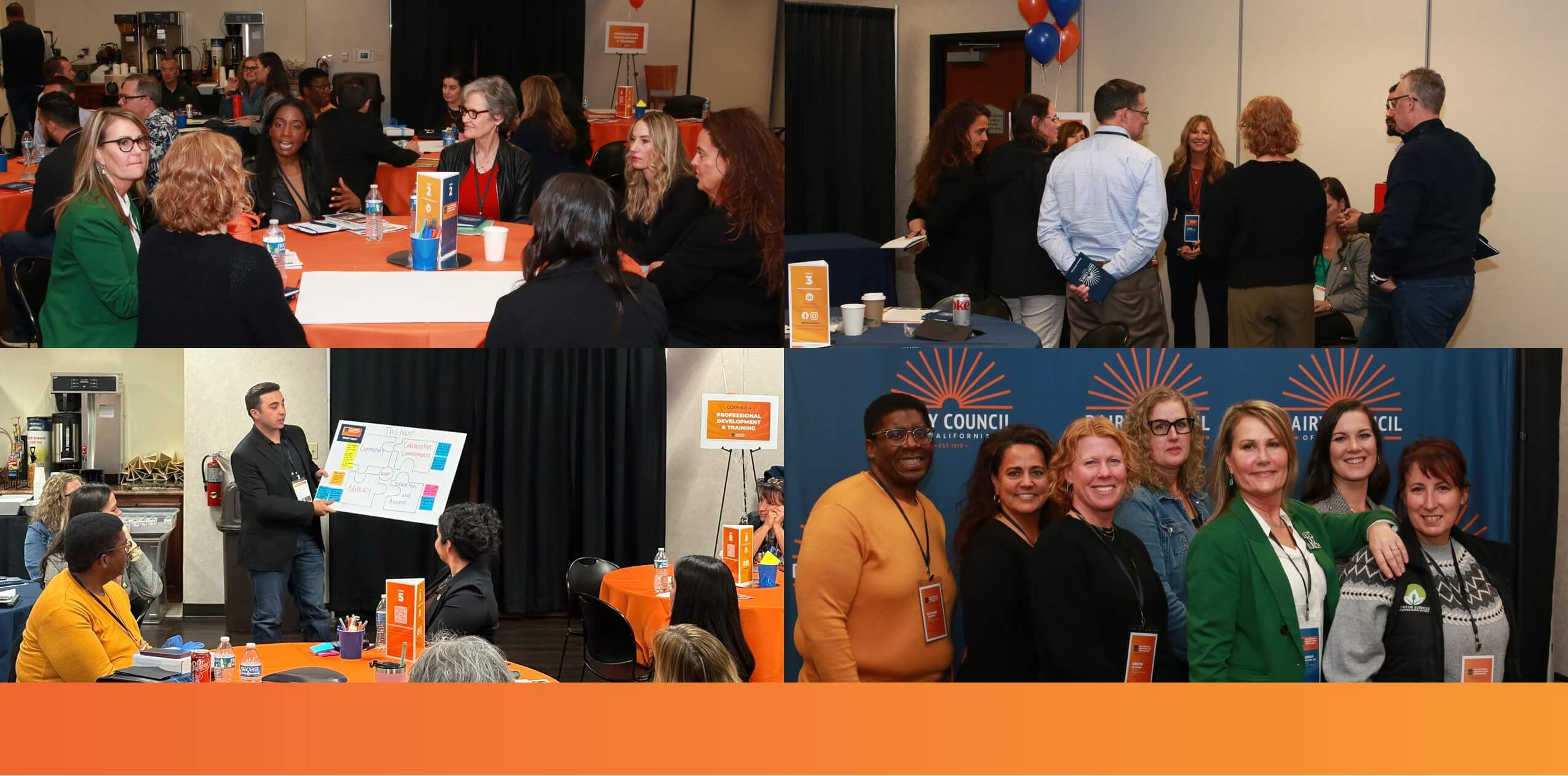
During the Now What session at the end of the day, attendees produced actionable recommendations and next steps:
The results of this endeavor exemplify the need for Dairy Champions across the state to continue investing in innovative solutions that promote student wellness and scholar success. To realize the shared vision from the Dairy Dialogue requires collaboration
among school nutrition leaders, promoting dairy’s value in unique and creative ways while expanding dairy options for meaningful integration at the center of the plate.
By working together across sectors, everyone has a role in shaping
more equitable, sustainable and nourishing school meals by driving innovation, elevating nutrition education and positioning dairy’s important role in fueling scholar success.

i. Bradley BJ, Greene AC. Do health and education agencies in the United States share responsibility for academic achievement and health? A review of 25 years of evidence about the relationship of adolescents’ academic achievement and health behaviors. J Adolesc Health. 2013;52(5):523-532. DOI:10.1016/j.jadohealth.2013.01.008
ii. Krebs-Smith SM, Guenther PM, Subar AF, Kirkpatrick SI, Dodd KW. Americans do not meet federal dietary recommendations. J Nutr. 2010;140(10):1832-1838. DOI:10.3945/jn.110.124826 iii. Quann EE, Fulgoni VL, Auestad N. Consuming the daily recommended amounts of dairy products would reduce the prevalence of inadequate micronutrient intakes in the United States: diet modeling study based on NHANES 2007–2010. Nutr J. 2015;14(90). DOI:10.1186/s12937-015-0057-5